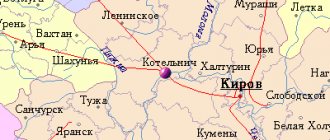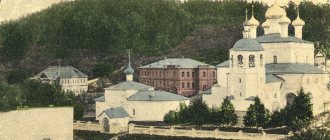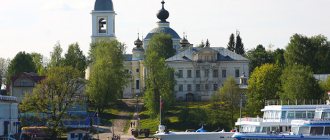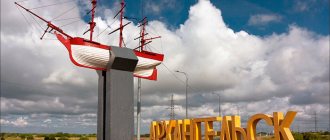Ancient Ustyuzhna. Now - a small town in the Vologda region, and once - the center of blacksmithing and weapons manufacturing, Ustyuzhna Zhelezopolskaya. In the name “Ustyuzhna” the stress falls on the first syllable. For the first! As in the name of our other ancient city - Veliky Ustyug. Both names come from the mouth. When looking for a convenient location for a settlement, the first settlers always paid attention to how protected the area was. Therefore, sites were often chosen at the confluence of rivers, that is, at the mouth of one of them.
The first settlement on the site of modern Ustyuzhna appeared in ancient times. It was located on the modern outskirts of the city, where the Izhina River flows into Mologa (hence the name - Ust-Izhina, Ustyuzhna). Here there was a settlement and a temple, where on Ivan Kupala the then Ustyug residents held idolatry, accompanied by the usual “indecency” for such occasions.
In ancient times
The first chronicle mention of the city dates back to 1252 (in the Uglich Chronicle). In the 14th century we already find it in the sphere of Moscow interests. Novgorod was much closer to it, but this proximity was expressed for the most part not in cultural and economic influence, but in the frequency of raids, and oh, how hard it was for the Ustyug residents from the willful Novgorodians.
In 1389, Dmitry Donskoy bequeathed Ustyuzhna to his son Peter, in 1405 it went to another Donskoy’s son, Konstantin. And in 1462-1492 it was owned by Ivan III’s brother Andrei Vasilyevich Bolshoi, whose main “residence” was in Uglich. This prince is also known in history as “Andrey Goryai” - and for good reason. He ended his life in chains, falling victim to his brother’s idea of centralizing power (the same fate befell his sons). And Ivan Vasilyevich took Ustyuzhna into his hands and bequeathed it to his son Dmitry. He died in 1521 childless, and the inheritance returned to the Grand Duke of Moscow, who was then Vasily III.
A little history of Ustyuzhna. Curious facts
Fact number 1, the most ancient.
They sometimes say that people have lived somewhere from time immemorial, that is, from those times that no one remembers for sure and can’t even be found in the chronicles. This is just about Ustyuzhna. Let's start with the fact that, according to archaeological excavations, in these places there was one of the most ancient sites in the Russian North. This means that people settled on the high banks of the Mologa immediately after the end of the Ice Age. Also, no one knows for sure the exact date of the founding of the city. In the Novgorod chronicles, Ustyuzhna is mentioned in the middle of the 14th century, in Uglich - in the middle of the 13th century. Therefore, the founding year is considered to be 1252. But this is not certain.
Fact number 2, the most beautiful.
How do you feel about the letter Z? In our opinion, it sounds very nice. That’s why the history of the origin of the city’s name seems fascinating to us. No, it’s not about legends, but about the beauty of the Russian language. The city is located on the Mologa, in the place where the tributaries Izhin and Vorozh flow into it. Therefore, initially the city was called Ust-Izhina, but gradually transformed into Ustyuzhna Zheleznopolskaya, and then simply into UstyuZhna.
Fact number 3, the most official.
Because what could be more official than the city’s coat of arms? And the coat of arms of Ustyuzhna is unusual. At first glance, it seems that there is a pile of stones on the red field. No, these are not stones at all, but “iron kritsy, which the inhabitants of this city trade in, and get this iron from the nest ore, which the surroundings of this city abound in.” Yes, Ustyuzhna for a long time was the center of production and processing of swamp and lake iron ore, and Izhinsky The ironworks provided the entire Russian army with muskets and cannons. Until Peter I transferred all production to Tula and the Urals.
Fact number 4, the most museum-worthy.
Ustyuzhna is often called a museum city. Indeed, despite the Soviet quarters in the southeast, the historical part of the city has remained almost untouched, dating back to the 18th century and even earlier. Therefore, wandering here is a pleasure, as if you are transported back in time to the age of stately stone churches, rich merchant houses, peasant settlements, noisy fairs and measured provincial life. This is better than any 3D visualization.
Fact No. 5, the most renamed.
According to residents, not a single city suffered from renaming as much as Ustyuzhna: “Not a city, but some kind of set of political toponyms.” St. Lenina smoothly turns into Karl Marx, st. Kommunarov, Proletarskaya, lane. Free worker, etc. There is even an alley of cosmonaut Valentina Tereshkova. The historical name was returned only to Cathedral Square, which in Soviet times bore the name of the Victims of the Revolution.
“It’s high time not only to think about it, but also to return the streets to their original names. Bolshaya Moskovskaya, Bolshaya Novgorodskaya, Kozmideyansky lane, Peterburgskaya street. They sound much more beautiful."
Surprisingly, the city itself never changed its name.
Heyday
By this time, changes had occurred in the Moscow principality that radically affected the life of Ustyuzhna: Novgorod, whose lands it bordered, was annexed to Moscow, and our city ended up in. From a border fortified point, it gradually turned into a large industrial - let's not be afraid of this word - center. Rich deposits of swamp ore contributed to this. Naturally, the main industry of Ustyuzhna was iron making. By the second half of the 16th century, there were about 6,000 inhabitants, of which 77 kept forges (for comparison, in Tula, which is much more famous in this regard, there were then only 30 forges).
The city grew rich, but all its buildings, including churches and monasteries, remained wooden.
Administrative and municipal status
As part of the structure of administrative units, Ustyuzhna serves as the administrative center of the Ustyuzhensky District and of the Ustyuzhensky Selsoviet of that district, although it is not part of the latter.[1] As an administrative division, it is part of the Ustyuzhna district as a city of district significance of Ustyuzhna
.[2] As a municipal entity, the city of district significance of Ustyuzhna is part of the Ustyuzhna municipal district as the
Ustyuzhna Urban Settlement
and is the administrative center of the municipal district, urban settlement and Ustyuzhna rural settlement, although it is not part of the latter.[6]
Ustyuzhna in the Time of Troubles
In 1609, when “thieves’ people” tried to capture Ustyuzhna, it gained the glory of an impregnable city. But the people of Ustyug did not consider it their merit, knowing the real reason for the victory - the intercession of the Most Holy Theotokos.
During the Time of Troubles, Ustyuzhna provided an example of heroic resistance to the interventionists. Back in 1608, the residents of Ustyug supported the anti-Polish uprising of the Belozers and, having arrested representatives of the Tushino thief, began hastily building fortifications: it was obvious that the “rebellion” would not be in vain.
All residents fit for military service were enumerated and divided into hundreds, fifty and tens; Serving nobles were called from the district, and the militia elected “Solmen Otrepyev, Bogdan Persky, and the Ustyug clerk Alexei Suvorov” as their commanders. It is noteworthy that Solmen Otrepiev was apparently distantly related to the first False Dmitry - the fugitive monk Grigory Otrepiev.
How to get from St. Petersburg to Ustyuzhna
The distance between St. Petersburg and Ustyuzhnaya is 430 kilometers. If you go by personal car, the road is very simple. Along the E105 highway (Kola) to the intersection with the Volkhov River. After the river, turn left to Tikhvin and onto the A-114 highway to Cherepovets. Shortly before the village. Zhelyabov will need to turn left again - straight towards Ustyuzhna.
Buses to Ustyuzhna depart from the bus station on the Obvodny Canal daily and regularly. A few flights around 8am and a few around noon. Travel time is about 7 hours.
There is no railway connection between St. Petersburg and Ustyuzhnaya, because there is no railway in Ustyuzhnaya.
First attack
The Ustyuzhans, together with the Belozers, gave their first battle to the “Lithuanian people” on the approaches to Ustyuzhna, near the village of Bateevki. But the poorly prepared local militia lost the battle to the Lithuanians.
After the defeat at Bateevka, the city’s defenders did not lose heart. The worse the defeat, the hotter the work went. Everyone, both old people and children, worked to build earthen ramparts and wooden walls. Blacksmiths tirelessly forged self-propelled guns, arrowheads and spearheads.
On February 3, 1609, the sentinels “taught a flash in the fort, as if Lithuania and the Poles were coming to the fort.”
Colonel Mikulai Kosakovsky, who commanded a detachment of Tushins (which included “Lithuanians, Poles, Cherkassy, Germans, Tatars, Zaporoskiy Cossacks, and thieves from many Russian cities”), did not at all expect to see five-meter-high log walls in front of him. Only a month ago he was informed that Ustyuzhna had no fortifications and it would not be difficult to get provisions and other supplies there. And here it is - on you.
The first attack of the “thieves’ people” failed. But they were not going to give up so easily - having plundered and burned the houses and temples that remained outside the fortress walls, they retreated.
Second and third attacks
The second attack fizzled out, like the first, despite all the “cunning and intrigues.” However, it became increasingly difficult for the Ustyug residents to repel attacks. My strength was running out. Realizing this, the Poles decided to launch a third attack.
It was on the night before him in the cathedral church of the Nativity of the Blessed Virgin Mary that the sexton saw the appearance of the Smolensk Icon of the Mother of God. Praying to the Most Holy Theotokos for intercession from his enemies, he heard a voice from the icon: “Man, order Me to be carried near the prison where the wretched people come: I will not allow My house to be destroyed by foreigners.” In the morning, he reported to the clergy that the Mother of God had promised not to leave the city’s defenders in trouble. The icon with prayer singing was lifted and carried to the walls.
And then a new miracle happened. The same sexton, to whom the voice from “Hodegetria” was addressed, “soon ran” to the priests carrying the image of the Mother of God, and said, “as the local icon of the Most Pure Mother of God of Her honorable and glorious Birth moved from her place and stood about herself among churches".
They also took this icon to the wall. Meanwhile, the attack had already begun. The enemies, seeing the fatigue of the defenders, “began to attack more, suffering all sorts of torment and ruin.” But the presence of miraculous icons—the news of the events of the previous night had already spread throughout the city—encouraged the people. They not only repelled the attack, but launched a counterattack themselves, opening the gates.
The losses of the interventionists were great. They fled from the walls of Ustyuzhna, abandoning carts and supplies. Soon, however, reinforcements approached them, and their previous fears were forgotten. The city had to withstand another assault, but its defenders, encouraged by the intercession of the Mother of God shown to them, already knew exactly what to do. Seeing the approaching regiments, they hastily headed to the church.
The last attack was the most desperate. Enemies rushed towards the fort from all sides. All Ustyug residents stood on the walls “with their wives and children.” Those who could fight with a sword did so with a sword. Anyone who could shoot with a bow or crossbow did so. They used stakes, pitchforks, and axes. Boiling water, var, and sewage were poured onto the heads of the attackers... At some angry moment it seemed that just a little more and the end would come. But then again they carried “Hodegetria” along the walls with prayer singing.
Finally, the Ustyun residents managed to win a decisive victory. But they attributed this success not to themselves, but to the intercession of the Most Holy Theotokos. And since then, February 10 - the day of the last fierce battle under the walls of the fort - was celebrated by the whole city, “so that such a glorious miracle will not be forgotten in the future by the future generation.”
Decline
By the end of the 16th century, Ustyuzhna was “stolen”: only a third of the households remained in it compared to the previous one, and the number of residents decreased three times. The monks of the Mother of God Monastery of the Nativity also tried on or scattered.
During the Time of Troubles, the interventionists were unable to capture Ustyuzhna, the few inhabitants of which heroically withstood their siege, but this time was still very difficult for the city. The former Mother of God Nativity Monastery was also completely deserted. In 1622, already during the reign of Mikhail Fedorovich, a new church was erected in its place with the same dedication - and with the chapels of Sretensky, Vladimir (in honor of the Vladimir Icon of the Mother of God) and the Annunciation.
With the discovery of iron ore in the Urals, the Ustyug swamp ore lost its industrial significance, and the city - which became a district town in 1738 - lived very quietly, occupying only fifth place among the trading cities of the Novgorod province, to which it belonged since 1727.
Recommendations
Church of the Kazan Icon of the Mother of God (early 18th century)
Notes
- ^ a b c d f
Permit No. 178 - ^ a b c
Law No. 371-OZ - ^ a b c d f g gram hour i j
N. V. Soldatova (2006). G. V. Sudakov (ed.). Vologda Encyclopedia (PDF) (in Russian). Vologda: VSPU, Rus. pp. 488–489. ISBN 5-87822-305-8. Retrieved November 27, 2013. - ^ a b
Federal State Statistics Service of Russia (2011).
“All-Russian Population Census 2010. Volume 1" [All-Russian Population Census 2010, vol. 1]. All-Russian Population Census 2010 [All-Russian Population Census 2010]
(in Russian). Federal State Statistics Service. - "26. The size of the permanent population of the Russian Federation by municipalities as of January 1, 2022.” Federal State Statistics Service. Retrieved January 23, 2022.
- ^ a b c d f
Law No. 1126-OD - "On the calculation of time." Official Internet portal of legal information
(in Russian). June 3, 2011. Retrieved January 19, 2022. - Post office. Information and computing center of OASU RPO. ( Post office
).
Search for postal facilities ( Search for postal facilities
) (in Russian) - Federal State Statistics Service of Russia (May 21, 2004). “The population of Russia, the constituent entities of the Russian Federation as part of federal districts, urban settlements, urban settlements, settlements, settlements of 3 thousand or more people.” [Population of Russia, its federal districts, federal subjects, districts, urban settlements, rural settlements - administrative centers, rural settlements with a population of more than 3000 people] (XLS). All-Russian Population Census of 2002 [All-Russian Population Census of 2002]
(in Russian). - “All-Union Population Census of 1989. Current population of union and autonomous republics, autonomous regions and districts, territories, regions, urban settlements and villages. Geographical names of the world,” p. 436
- Decree on the establishment of provinces and on the designation of cities for them (in Russian)
- Snytko, O. V.; and others. (2009). S.D. Trifonov; T. B. Chuikova; L. V. Fedina; A. E. Dubonosova (ed.). Administrative-territorial division of the Novgorod province and region 1727-1995. Directory (PDF) (in Russian). Saint Petersburg. paragraphs 16–22. Retrieved November 27, 2013.
- ^ a b c d
Information on changes in the administrative-territorial structure and network of party and Komsomol bodies of the Vologda region (1917–1991) (in Russian). Archives of Russia. Retrieved November 27, 2013. - Encyclopedia of Russian Cities
. Moscow: Great Russian Encyclopedia. 2003. p. 497. ISBN 5-7107-7399-9. - Monuments of history and culture of the peoples of the Russian Federation (in Russian). Ministry of Culture of Russia. Retrieved June 2, 2016.
- Ustyuzhensky Museum of Local Lore (in Russian). Russian Network of Cultural Heritage. Retrieved November 27, 2013.
- Osipov, G. (2009). Inspector on Mologa: Will Nikolai Vasilyevich help Ustyuzhna to be revived? . Culture
(in Russian).
13
. Retrieved November 27, 2013.
Sources
- Legislative Assembly of the Vologda Region. Law No. 371-OZ of June 4, 1999 “On the decision of the administrative-territorial Vologda region,” as amended. Law No. 2916-OZ of December 7, 2012 “On Amendments to the Law of the Region” On Issues of the Administrative-Territorial Structure of the Vologda Region “”. Came into force on the date of official publication. Published: “Red North”, No. 124–125, July 29, 1999 (Legislative Assembly of the Vologda Region. Law No. 371-OZ of June 4, 1999. On issues of the administrative-territorial structure of the Vologda Region
As amended by the Law of 12/07/2012 No. 2916-OZ.
On amendments to the regional law "On issues of the administrative-territorial structure of the Vologda region"
. Valid from the date of official publication.). - Government of the Vologda region. Resolution No. 178 of March 1, 2010 “On approval of the register of administrative-territorial units of the Vologda region,” as amended. Resolution No. 686 of June 25, 2012 “On amendments to some Resolutions of the Regional Government.” Entered into force on March 20, 2010. Published: “Red North”, No. 29, March 20, 2010 (Government of the Vologda Region. Resolution No. 178 of March 1, 2010. On approval of the Register of administrative-territorial units of the Vologda Region
As amended by Resolution No. 686 of June 25, 2012.
On amendments to various resolutions of the Regional Government
. Effective from March 20, 2010). - Legislative Assembly of the Vologda Region. Law No. 1126-OZ of December 6, 2004 “On establishing the boundaries of the Ustyuzhensky municipal district, the boundaries and status of the municipalities included in its composition,” as amended. Law No. 2809-OZ of July 5, 2012 “On amendments to certain regional laws establishing the boundaries and status of municipalities.” Came into force 10 days from the date of official publication. Published: “Red North”, No. 242, December 11, 2004 (Legislative Assembly of the Vologda Region. Law No. 1126-OZ of December 6, 2004 On establishing the boundaries of the Ustyuzhensky municipal district, on the boundaries and status of its constituent municipalities
V edition of the Law dated 07/05/2012 No. 2809-OZ.
On amendments to various laws of the region, establishing the boundaries and status of municipalities of the region
. Valid after 10 days from the date of official publication.).










